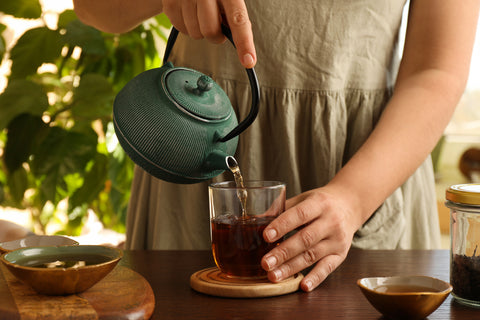A teapot with teacups is an essential crockery in every household, not just in Britain but worldwide. It is the culture of drinking tea that inspires people to purchase beautiful teapots and teacups. The British love their teapots and teacups so much that they like to spend on luxurious sets of teapots and teacups. Let us explore some more details on teapots and teacups:
While there is some evidence of when teapots were discovered, it is quite certain that cups have been used before recorded history, and they have been uncovered across the globe in almost all archaeological sites. Irrespective, tea is now a daily part of our lives, and while some drink it as a beverage to begin their mornings or refreshen their late afternoons, it is a ritual for many who like to enjoy it not just by drinking it but also by preparing and serving it in the right way.
Role of Teapots in Drinking Tea

Using the right teapots and teacups in preparing and serving tea is essential in getting the perfect beverage. This is why the materials used in the preparation or brewing of the tea are significant. The type of teapot used in brewing the tea leaves plays a vital role in determining the flavour and also makes a difference in the overall experience of drinking tea.
Teapots have been designed in various forms and materials over the years to meet various needs. Let's look at the various elements that must be considered before selecting a standard teapot.
The Teapot Chamber
The teapot chamber is where the tea and water are stored. The chamber must be large enough to allow the tea leaves to expand along with the water to flow. The simplest way to tell if a teapot has a large enough chamber is to look at the tea after you have finished brewing it. If a lot of space remains in the chamber, it is a decent size. If the tea leaves appear compacted, you should go for a bigger size. Begin by examining the shape of the chamber - the larger the chamber, the better.
Infusers, too, have an important part to play in the making process. The infuser baskets are made from mesh and help strain the tea. It also helps to clean the teapot easily. They are good for preparing tea every day, but it should be wide enough. If the infuser basket is too small, the tea leaves will never fully open, which will not allow the flavours to seep into the water completely. If you want a cup of flavourful tea, it is not ideal to stuff tea leaves in a small space.
Teapot Materials

Teapots are available in many types of materials, including ceramic, clay, glass, aluminium, porcelain, cast iron, and silver. Every material offers a unique set of advantages, and at the same time, there may be some disadvantages, too.
Back in the days when the British were new to teapots and teacups, they faced some issues with teapots. The heat of the water in the British teapots often caused them to explode or break. According to teapot expert Henry Sandon, this is the reason why ladies would use the best Chelsea ware to warm the pot first. Fortunately, in the year 1750, Dr. John Wall and a physician named William Davis developed a method utilizing soap rock to create stronger china. This led to the creation of the Royal Worcester Pottery in 1751.
Porcelain teapots

The walls of porcelain teapots, which are most frequently used for brewing white and green teas. They are generally thinner than those of ceramic teapots and have a low heat transmission in comparison to other materials. Therefore, they effectively retain the tea's temperature for a shorter time than ceramic teapots. Porcelain teapots would be ideal for white and green teas as they are brewed at a lower temperature.
However, they are not as good for brewing black teas because they are poor at retaining heat.
Glass teapots
If you are someone who would like to observe the brewing process of your tea, then glass is a perfect material for teapot. Normally, glass teapots have thin walls, but they can be thicker. The material is not a good insulator, so you shouldn't expect the brewed tea to stay warm for a long time. However, they are definitely better than metal teapots. The fact that we can see the brewing process and the colour of infusion, it can help in understanding the duration of the steeping process of various tea leaves and the brands that they come from.
Ceramic teapots
Ceramics is a favoured material in teapots and teacups. They are great insulators of heat and keep the contents warm for a long time. They come with glazed interiors that prevent the flavours of the tea from being absorbed into the walls. It also means the tea will be more flavourful and stronger.
Because black teas are brewed at a higher temperature, porcelain ensures less temperature loss and that the tea stays warm for a long time.
Metal teapots
Teapots made of stainless-steel metal are elegant, robust, and traditional. They usually have attached infusers for easy loose-leaf brewing. The majority of premium metal teapots have a neutral flavour, while some may leave your tea tasting slightly metallic if left in for an extended period.
Teacups

Like teapots, teacups also come in different materials, such as porcelain, glass, bone china, stainless steel, and ceramic.
Teacups must be selected wisely – they should not be made from porous materials, and they will retain the flavours of the tea and change the original taste of the brewed tea.
Tea should always cool slowly. Tea poured in a small cup will retain heat, keeping it hotter for longer while also retaining its aroma. Wide-rimmed cups will allow the tea to cool more quickly. The cup will also get cold quickly if its walls are thin. Compared to glass, ceramic materials will hold heat longer.
A teacup’s lip should be thin so the tea easily slides in from the tip of the cup to your tongue.


 Easter 2026
Easter 2026
 Frozen Food
Frozen Food
 Baking
Baking
 Beans, Peas, Soups & Tins
Beans, Peas, Soups & Tins
 Biscuits, Crackers & Cookies
Biscuits, Crackers & Cookies
 Candy / Sweets
Candy / Sweets
 Crisps & Snacks
Crisps & Snacks
 Chemist / Pharmacy
Chemist / Pharmacy
 Desserts
Desserts
 Gravy, Stock & Paste
Gravy, Stock & Paste
 Haggis
Haggis
 Indian Sauces, Paste and Pickle
Indian Sauces, Paste and Pickle
 Jams & Preserves
Jams & Preserves
 Poppy Appeal
Poppy Appeal
 Pot Noodles & Super Noodles
Pot Noodles & Super Noodles
 Scone Mix
Scone Mix
 Gluten-Free / Free From
Gluten-Free / Free From
 Tea Accessories
Tea Accessories
 Teapot & Tea sets
Teapot & Tea sets
 Tea For One
Tea For One
 Sugar & Creamer
Sugar & Creamer
 Tableware
Tableware
 Serveware
Serveware
 Plates & Trays
Plates & Trays
 Bowls
Bowls
 Cups & Saucers
Cups & Saucers
 Mugs
Mugs
 Silverware
Silverware
 Dinnerware - Accessories
Dinnerware - Accessories
 Dinnerware - For Pets
Dinnerware - For Pets
 Victoria Eggs - Hand-Drawn UK Homeware
Victoria Eggs - Hand-Drawn UK Homeware
 Jewelry & Accessories
Jewelry & Accessories
 Sale
Sale
 Christmas Gifts
Christmas Gifts

